2011 Week 5
Each week this dispatch seems to begin with a weather report. Few things are more important to an archaeologist in the Chesapeake during the Summer than the weather. Those of you who experienced this week know that it was glorious! – low temperatures and low humidity. It will not last but we were all grateful. The only exceptions were the two students who, by the luck of the draw, were in the lab this week and missed it.
Work continued on uncovering the possible cellar hole on the east side of the site.
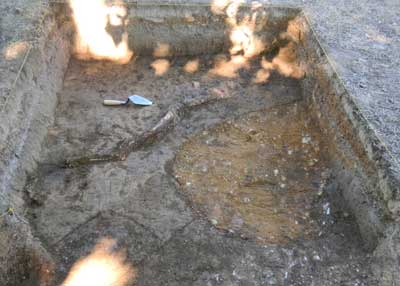
Eastern edge of the cellar hole impacted by a “pothole” in the old driveway.
Battling through the driveway fills, excavators found the edge of the feature and a portion of a post hole on the corner. In the lower left part of the photo both of these feature are evident. But the most prominent feature is the red, circular intrusion that occupies most of the right side of the frame. It is filled with hard-packed, multi-colored, pure clay. I had never seen anything like this before and was quite puzzled. After thinking about it for awhile, I believe this is a filled-in pot hole in the Brome-Howard House driveway. It was probably filled prior to placing the first gravel, sometime in the 19th century. By the end of next week, we expect to have the entire cellar feature exposed.
Much of our work this week was concentrated in the southwestern portion of the site. The midden continues to be rich and everybody is happy about finding things.
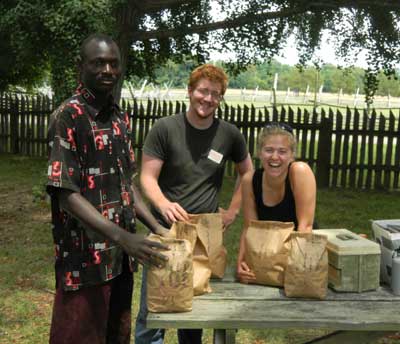
Abdoulie Sey, Stephen Warner and Sarah Shipley prepare five more bags of artifacts (all from one stratum) from the midden for transport to the lab.
We finished another midden stratum which produced five bags of artifacts, bone, shell, brick and other materials. All of these materials will be useful in determining when the midden was deposited.
However, none are more useful than the tobacco pipe fragments.
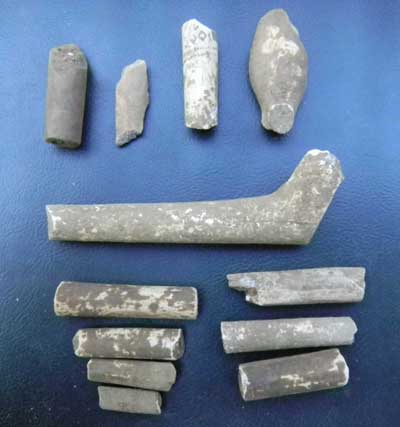
A selection of pipe fragments found one morning during excavation of a portion of the midden.
The photo shows a number of pipe fragments recovered one morning from the midden. The top two on the left are made of terra cotta and were produced either by the colonists or by Native Americans. They were in common use up to the 1670s. Adjacent to them is a white clay stem with rouletted decoration and a large piece of a white clay pipe bowl. The other pieces are all white clay pipe stems. Tobacco pipes are important archaeologically because they underwent rapid and significant change in the 17th century. Originally, tobacco was very expensive and the pipe bowls were small, the stems short and the hole in the stem was large. As tobacco became less expensive, the bowls got larger, the stems longer and the bore hole became smaller. By analyzing the sample of pipe fragments from a feature or a stratum, we can get a relatively good date on when it was deposited.
Last week I mentioned that one of our squares in the midden area was disturbed by a sewer trench. This was disappointing news but subsequent events mitigated that feeling. During excavation of the sewer trench, we found a fence line feature in the wall.
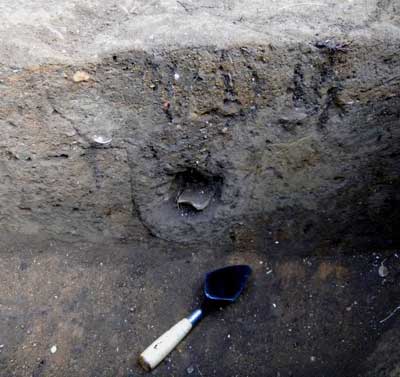
Profile of fence in sewer trench showing North Devon Gravel Tempered sherd.
A small corner of a ceramic was sticking into the trench, as we followed it back, we found it was a large piece of a gravel tempered ceramic made in North Devon, England in the 17th century. We could not see the fence in the midden originally but it was discovered about three inches down into it.
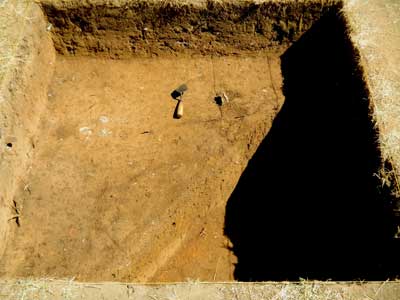
Plan view of fence in the midden and cut by sewer trench. Note large bone fragment protruding from the fence.
This suggests that the fence was constructed after the midden began to accumulate and was removed before that accumulation stopped. Materials in the fence trench were very similar to those in the midden itself, which would not be surprising since the fence trench cut through the midden.
Surprisingly, we were not finished with the unit. When the last of the midden was removed, another fence was found. It was a dark trench running east – west and appeared to be heading directly for the southwest corner of the Calvert House. This would be a very early fence for a number of reasons. Like all early fences on the site, it was set at an angle to the grid of about 45 degrees. All later fences reflect the orientation of the Calvert House itself. Secondly, there appears to be very little debris of any kind in the fence. This is significant because the fence was covered by the midden. It had to have been built and replaced before any significant midden accumulation had occurred. Even though this unit had been heavily disturbed by the sewer trench, it yielded two very important pieces of the fencing puzzle.
An interesting artifact recovered this week reminds us that this site was important long before the Maryland colonists arrived.
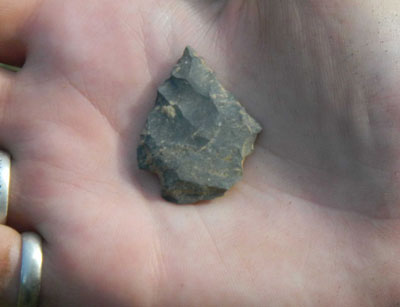
Native American projectile point.
The photo shows a projectile point tentatively identified as a Palmer Point. This style of point dates to 8000 – 7000 BC in a cultural period described by archaeologists as the Early Archaic Period. We are often asked how we can know the age of a piece of stone like this. A good analogy would be how one can tell the difference between a Model A Ford and a modern Ford. Styles change over time, they become popular and they fade. In our consumer-based society that kind of change is very rapid. While it was slower in the past, the same processes occurred. By looking at sites and stratigraphy, archaeologists built a style guide (what we call a typology) to projectile points. Using radiocarbon dating on sites has provided dates for many of the styles.
Next week, we go “beyond the pale.”


